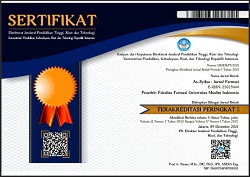AKTIVITAS ANTIOKSIDAN DARI TUMBUHAN PEPAYA (Carica papaya L.)
Abstract
Keywords
Full Text:
PDF (Bahasa Indonesia)References
Khaira K. Menangkal Radikal Bebas dengan Antioksidan. Sainstek. 2010;2(2):183–187.
Pratama AN, Busman H. Potensi Antioksidan Kedelai (Glycine Max L.) Terhadap Penangkapan Radikal Bebas. Jurnal Ilmiah Kesehatan Sandi Husada.2020;11(1):497–504.
Sepriyani H, Devitria R, Surya A, Sari S. Aktivitas antioksidan ekstrak metanol daun pepaya (Carica papaya L.) dengan metode 2,2-diphenyl-1-picrylhydrazil (DPPH). Jurnal penelitian farmasi indonesia. 2020;9(1):8-11.
Christalina I, Susanto TE, Ayucitra A, Setiyadi. Aktivitas Antioksidan dan Antibakteri Alami Ekstrak Fenolik Biji Pepaya. Jurnal Ilmiah Widya Teknik. 2018:18–25.
Miranti M, Lohitasari B, Amalia DR. Formulasi dan Aktivitas Antioksidan Permen Jelly Sari Buah Pepaya California (Carica papaya L.). Fiitofarmaka. 2017;7(1):37-43.
Sadhiutami NMD, Desmiaty Y, Anbar A. Efek Antioksidan Ekstrak Etanol Biji Pepaya (Carica papaya L.) terhadap Aktivitas Enzim Superoksida Dismutase dan Kadar Malondialdehid pada Mencit Stress Oksidatif dengan Perenangan. Jurnal Ilmu Kefarmasian Indonesia. 2016;14(1):26–32.
Marliani L, Velayanti R, Roni A. Aktivitas Antioksidan Dan Tabir Surya Pada Ekstrak Kulit Buah Pepaya (Carica papaya L.). Prosiding SNaPP2015 Kesehatan. 2015;1(1):319–324.
Sayuti K, Yenrina R. Antioksidan Alami dan Sintetik. Padang: Andalas University Press., 2015.
Sari WY, Yuliastuti D, Istiqomah. Uji Aktivitas Antioksidan Secara In Vitro Krim Fraksi Etanol 70% Daging Buah Pepaya (Carica papaya L.). Wijayakusuma Prosiding Seminar Nasional. 2020;1(1):166-168.
Sari K, Indrawati T, Taurhesia S. Pengembangan krim antioksidan ekstrak kulit buah pepaya (Carica papaya L.) dan ekstrak kulit buah rambutan (Nephelium lappaceum L.). Jurnal Farmasi Indonesia. 2019;16(1), 27-44.
Aravind G, Bhowmik D, Duraivel S, Harish G. Traditional and Medicinal Uses of Carica papaya. Journal of Medicinal Plants Studies. 2013;1(1):7–15.
Mayawati E, Pratiwi L, Wijianto B. Uji Efektivitas Antioksidan Ekstrak Metanol Buah Pepaya (Carica papaya L.) Dalam Formulasi Krim Terhadap DPPH (2,2-diphenyl-1-picrylhydrazil). Jurnal mahasiswa farmasi fakultas kedokteran UNTAN. 2014;1(1):1-11.
Pratiwi L, Wahdaningsih S. Formulasi dan Aktivitas Antioksidan Masker Wajah Gel Peel Off Ekstrak Metanol Buah Pepaya (Carica papaya L.). Jurnal Farmasi Medica/Pharmacy Medical Journal (PMJ). 2018;1(2):50-62.
Kurnia R. Fakta Seputar Pepaya : Manfaat Buah Pepaya dan Cara Membudidayakannya. Jakarta: Bhuana Ilmu Populer., 2018.
Khor B, Chear N, Azizi J, Khaw K. Chemical Composition, Antioxidant and Cytoprotective Potentials of Carica papaya Leaf Extracts: A Comparison of Supercritical Fluid and Conventional Extraction Methods. Molecules. 2021;16(5):1489.
Adachukwu I, Ogbonna A, Faith E. Phytochemical analysis of paw-paw (Carica papaya) leaves. International Journal of Life Sciences Biotechnology and Pharma Research. 2013;2(2):347–351.
DOI: https://doi.org/10.56711/jifa.v13i2.777
Refbacks
- There are currently no refbacks.
Indexed by:
ISSN: 2085-4714 | e-ISSN: 2502-9444
Editor's Address:
Faculty of Pharmacy, Univeristas Muslim Indonesia
2nd Campus of UMI: Jl. Urip Sumoharjo km. 5 , Makassar, South Sulawesi, Indonesia
E-mail: jurnal.farmasi@umi.ac.id















